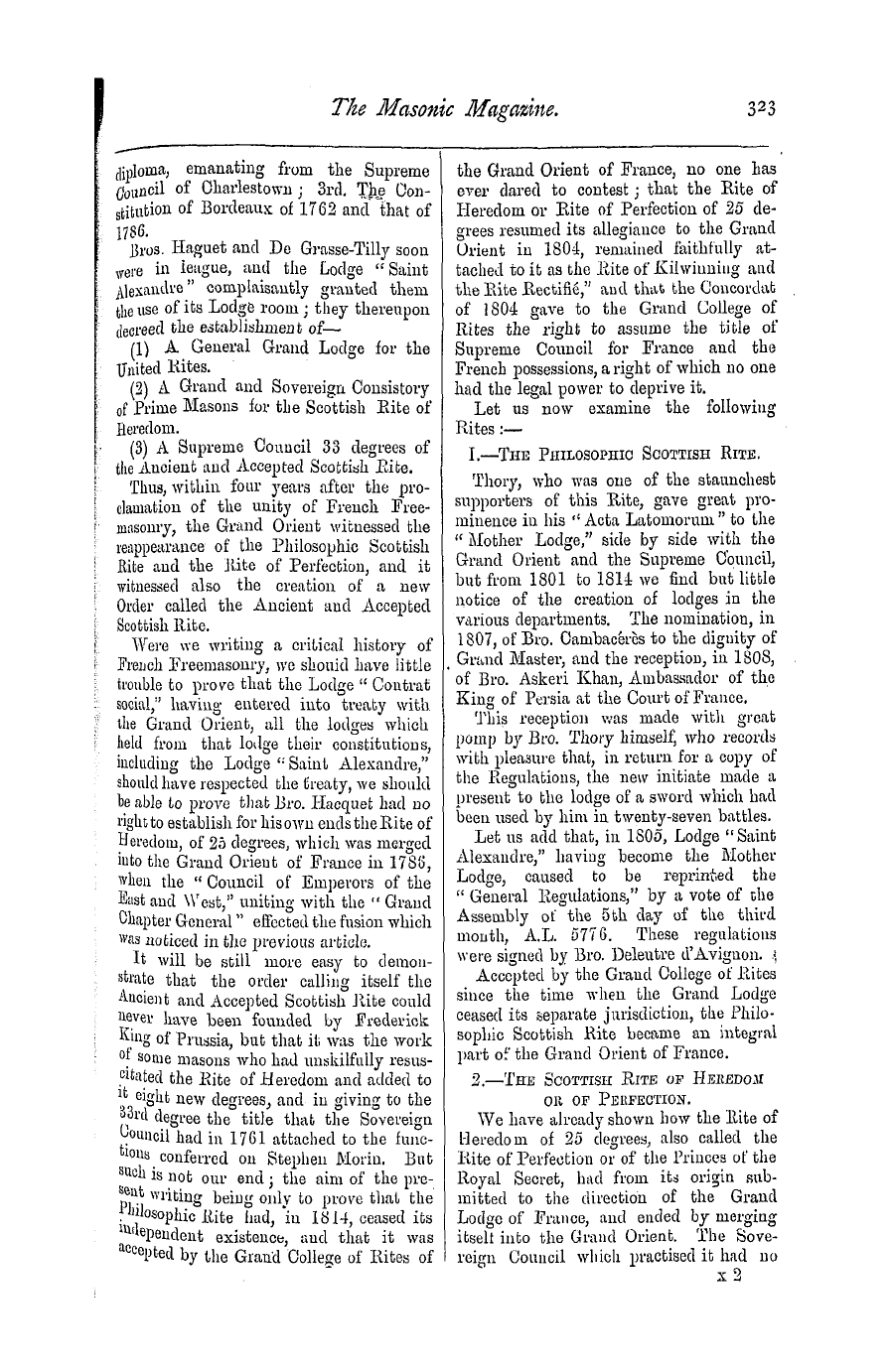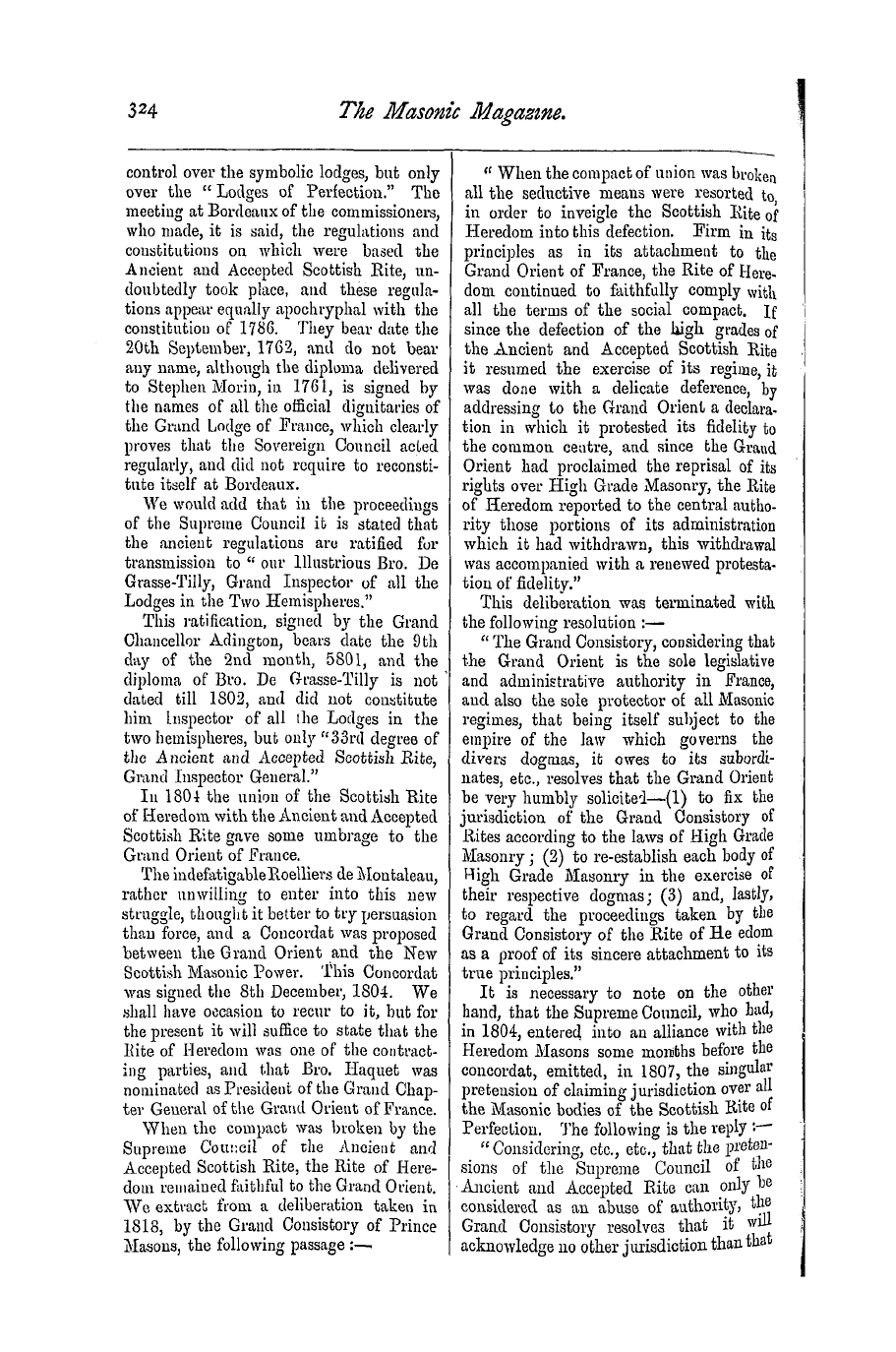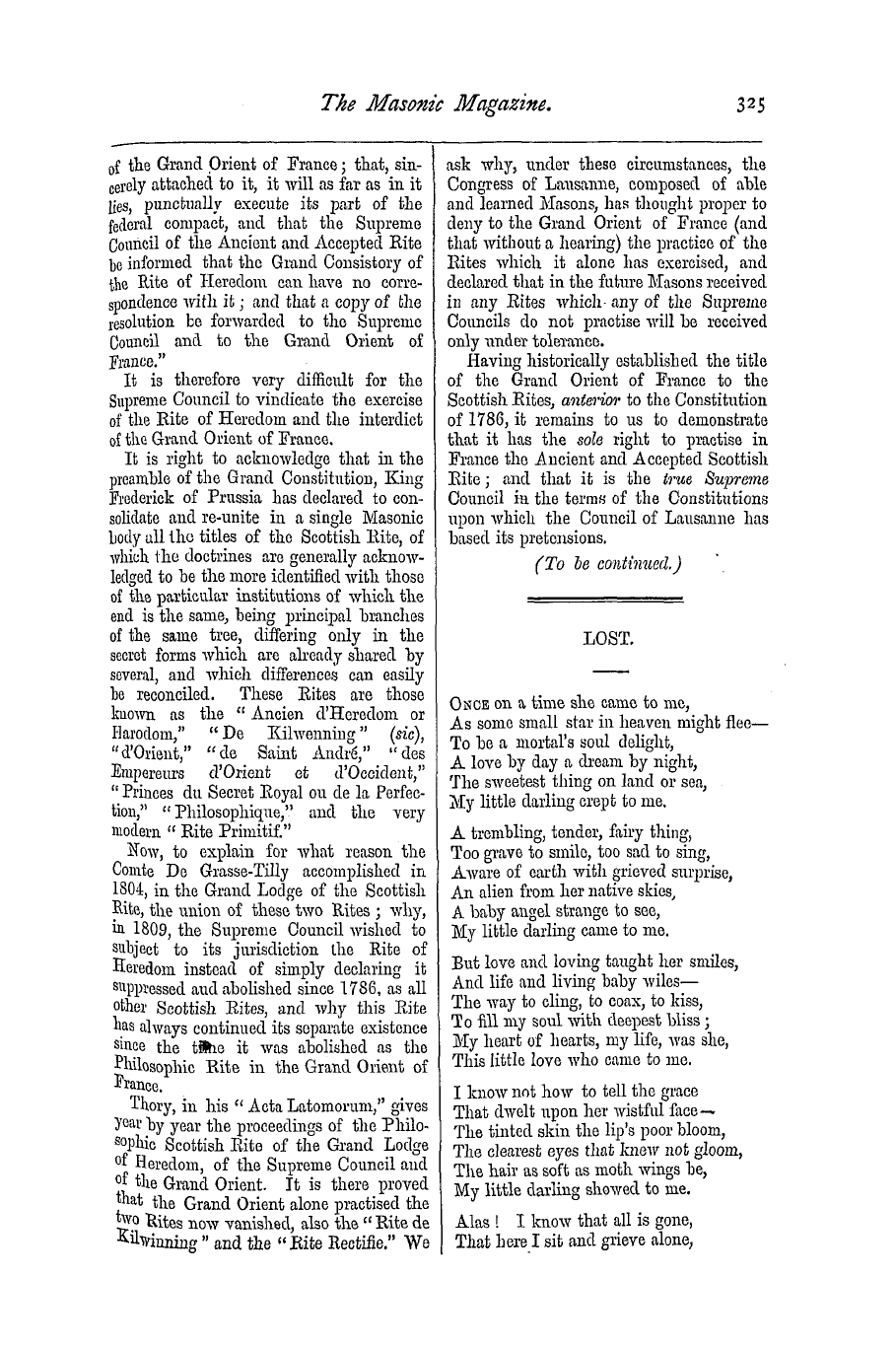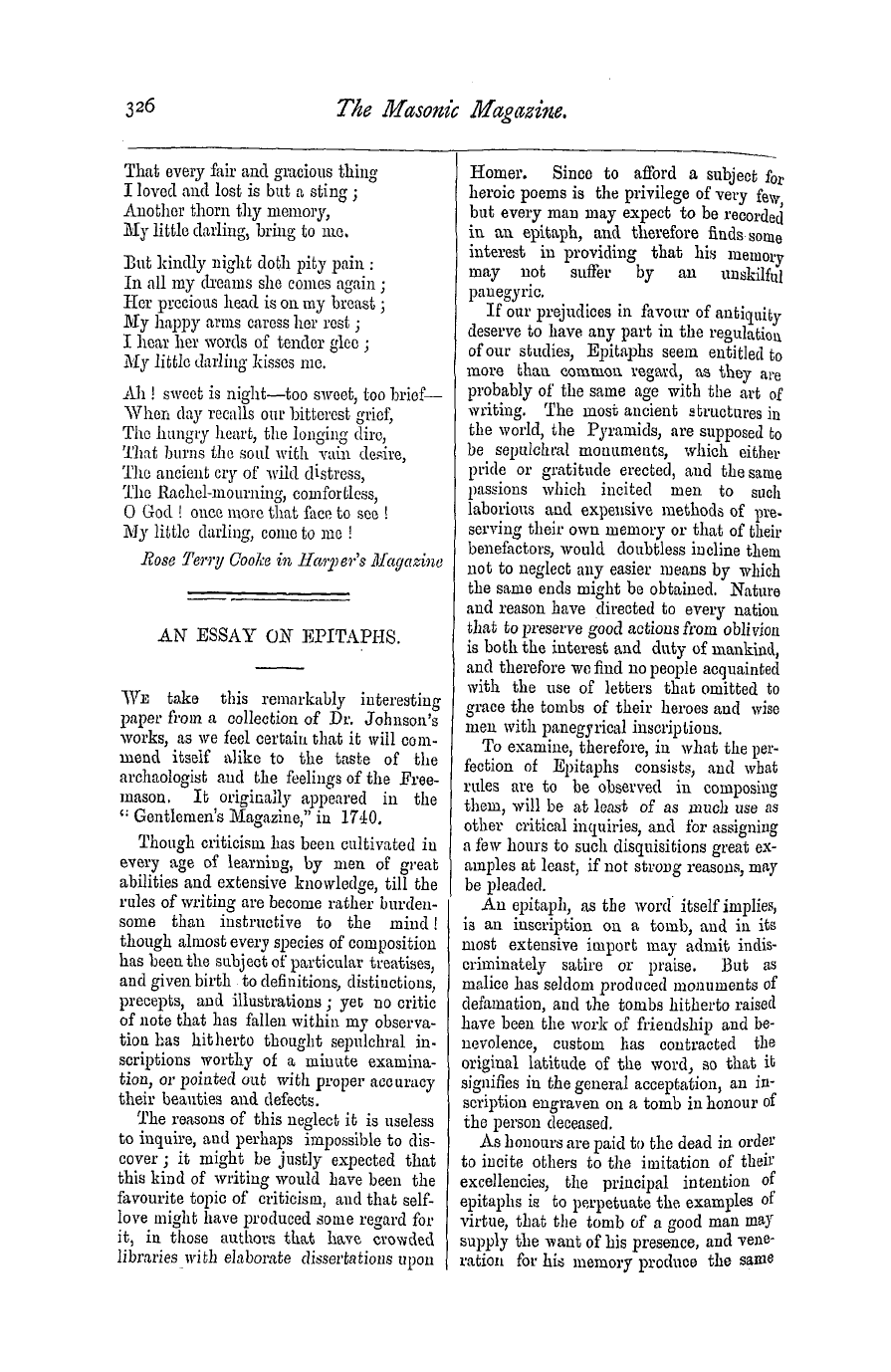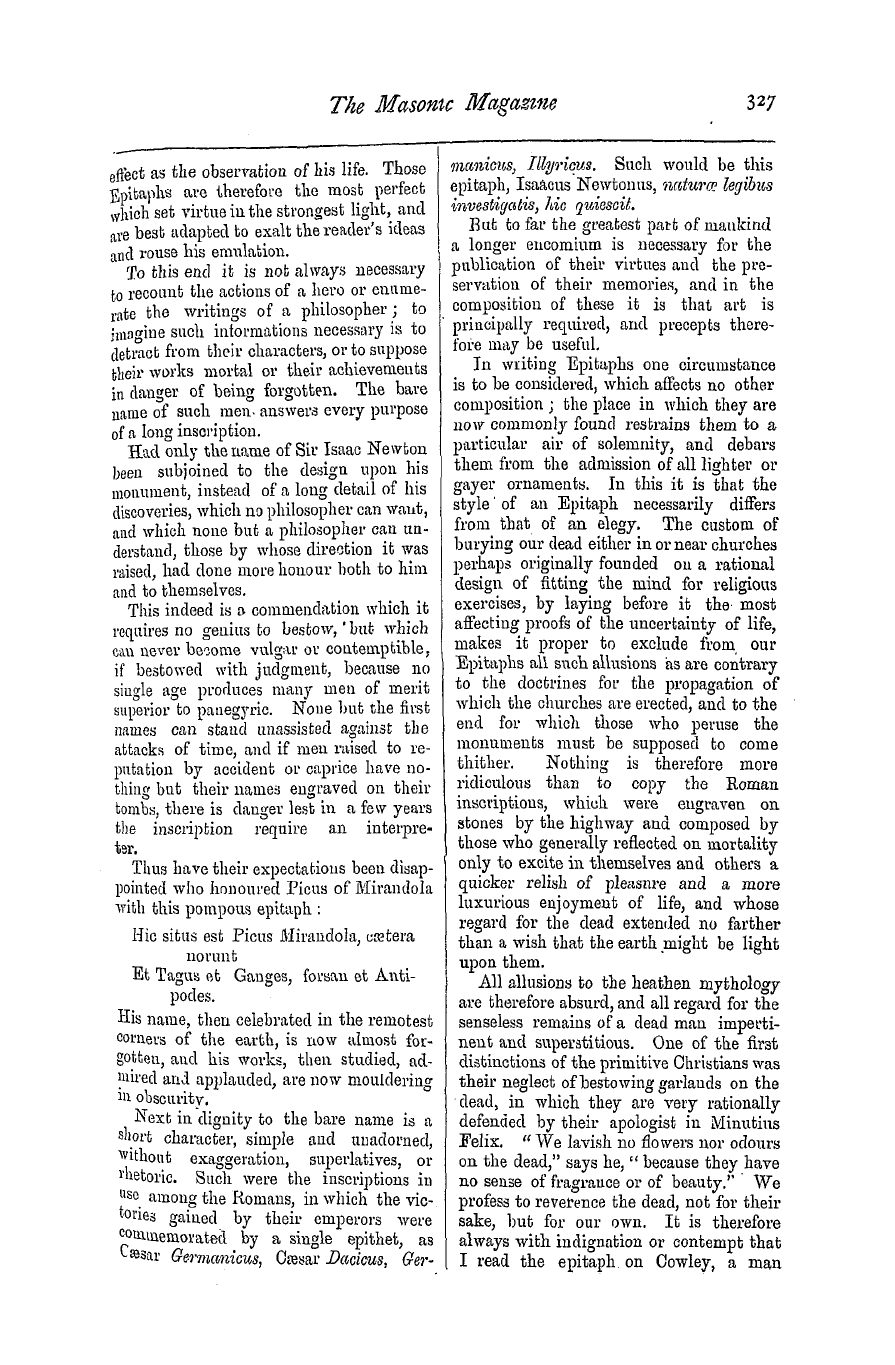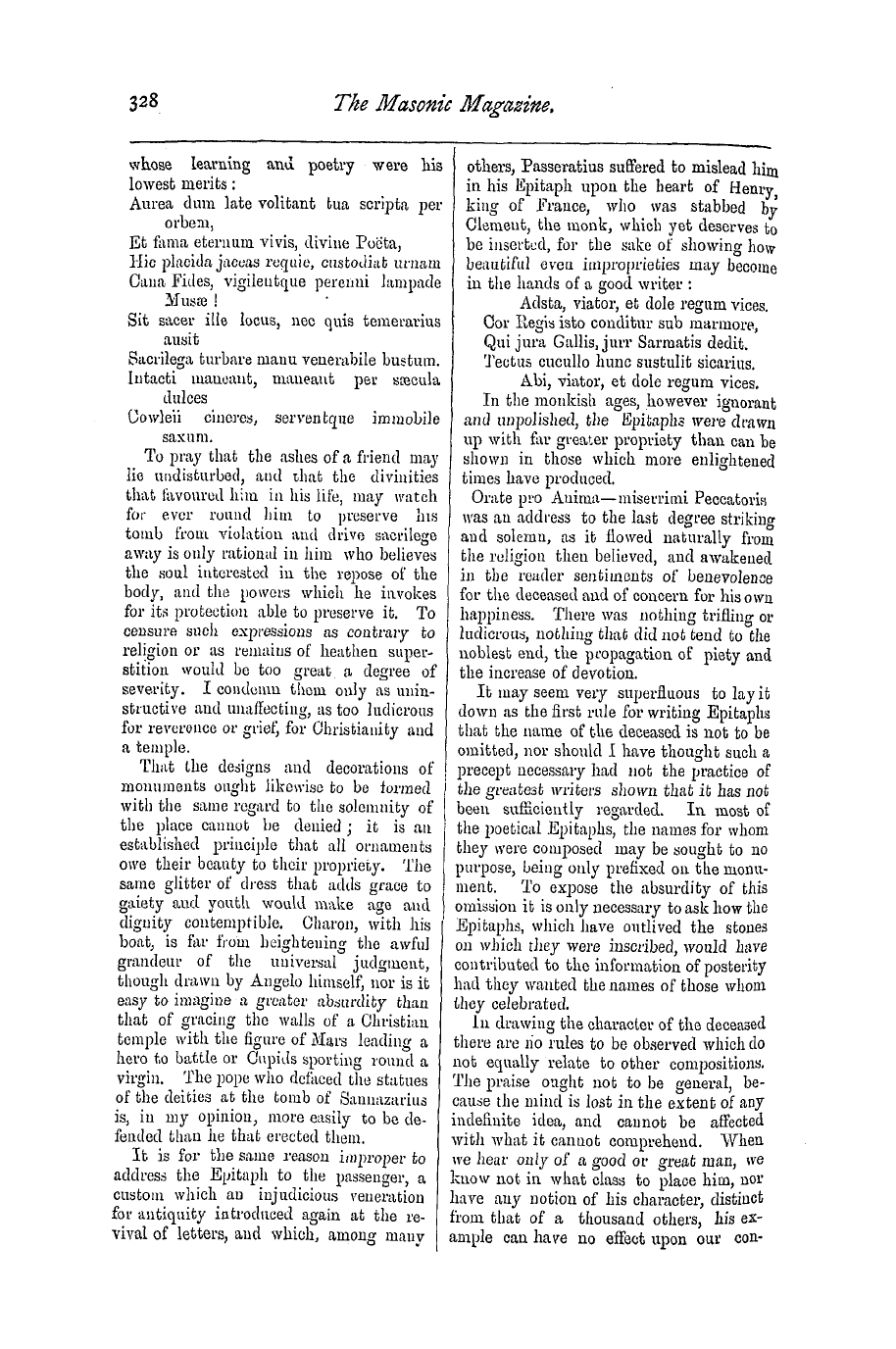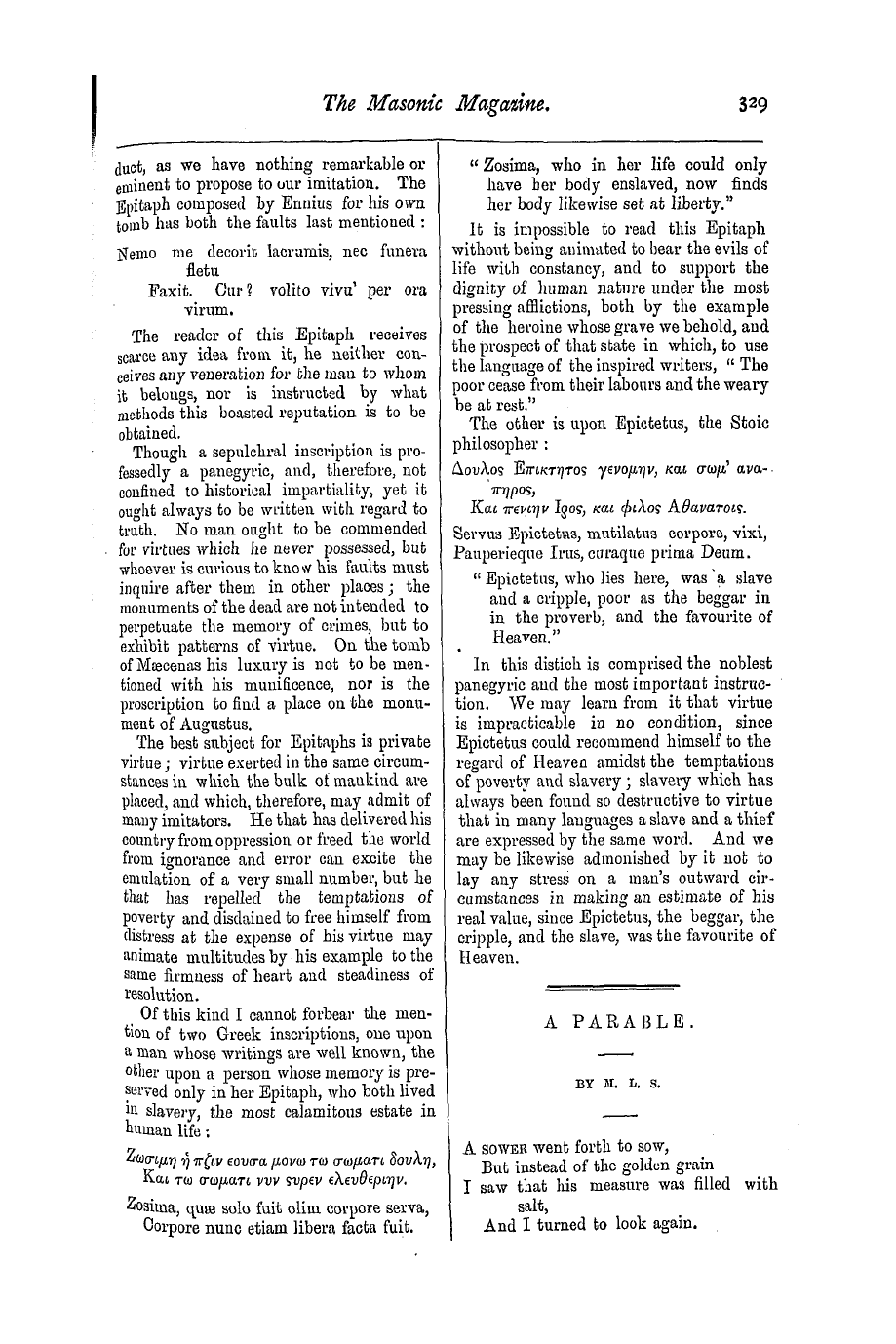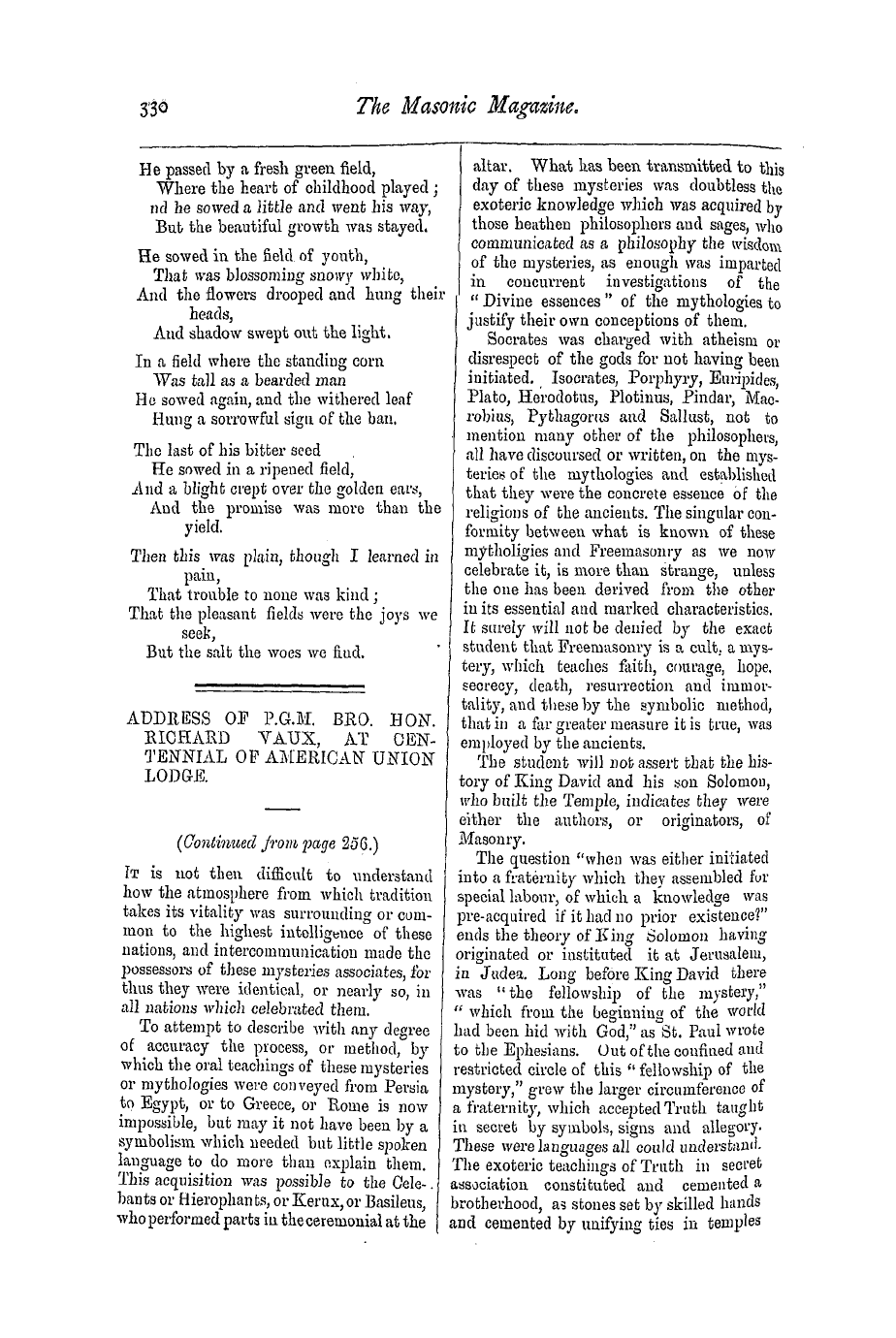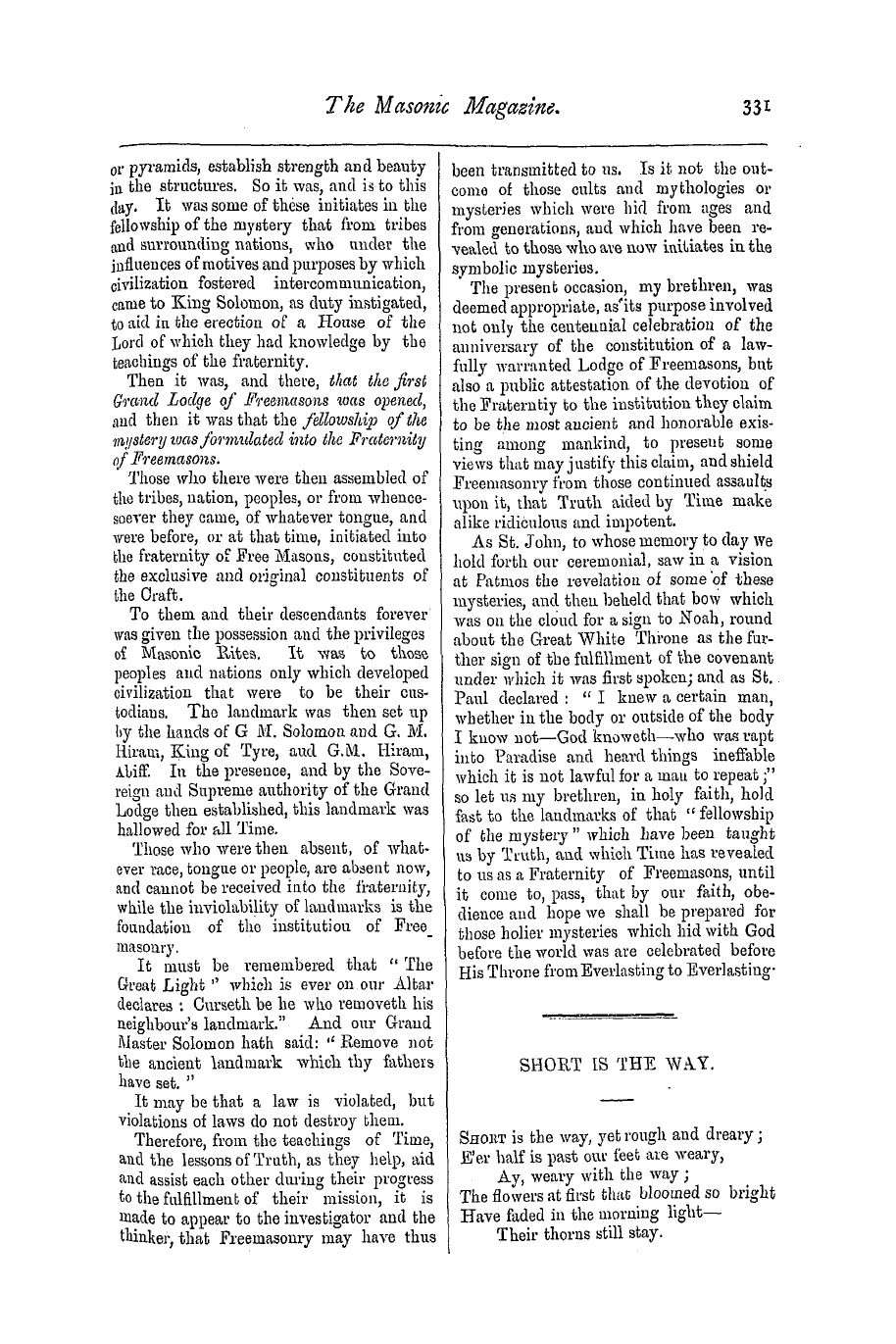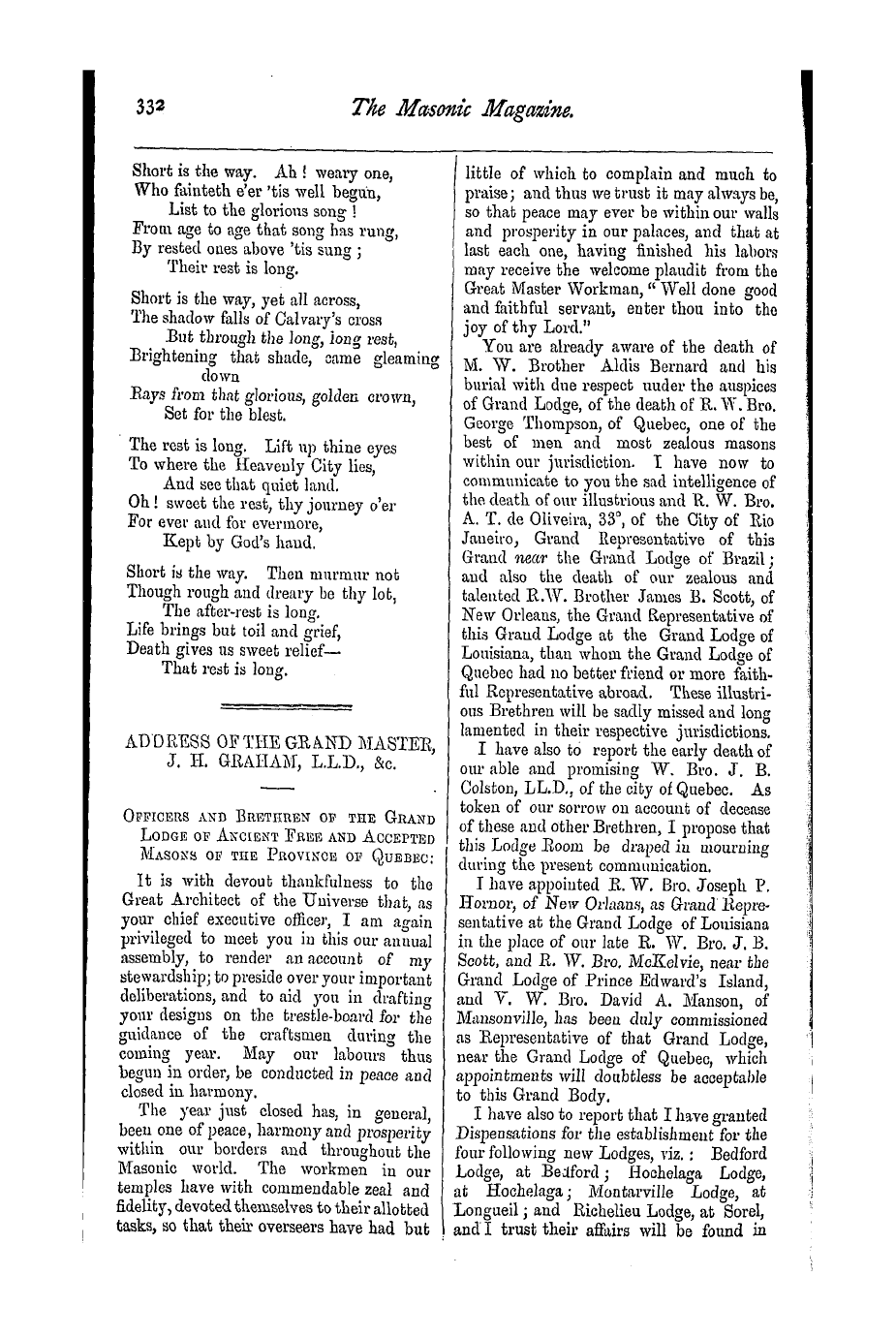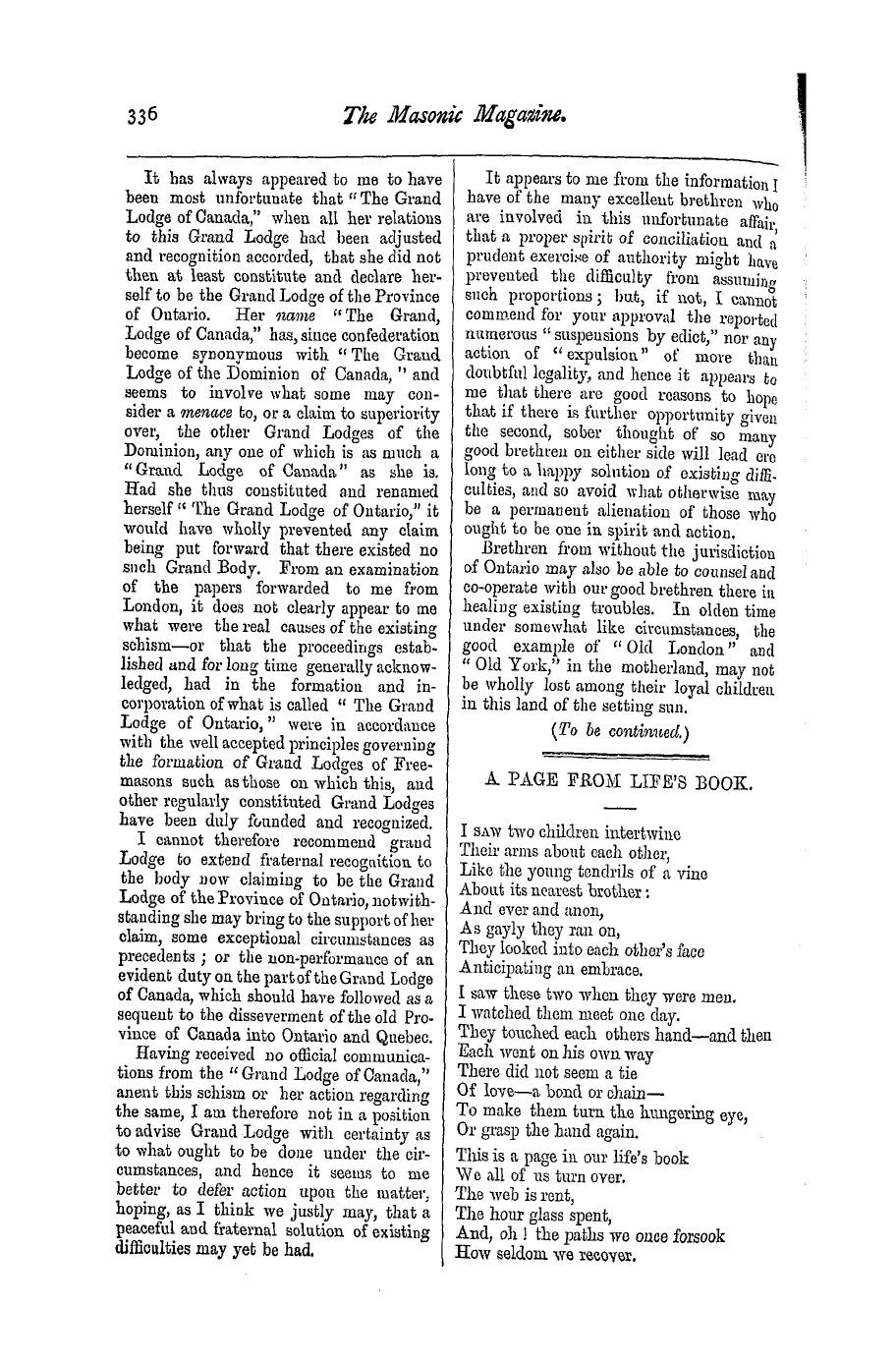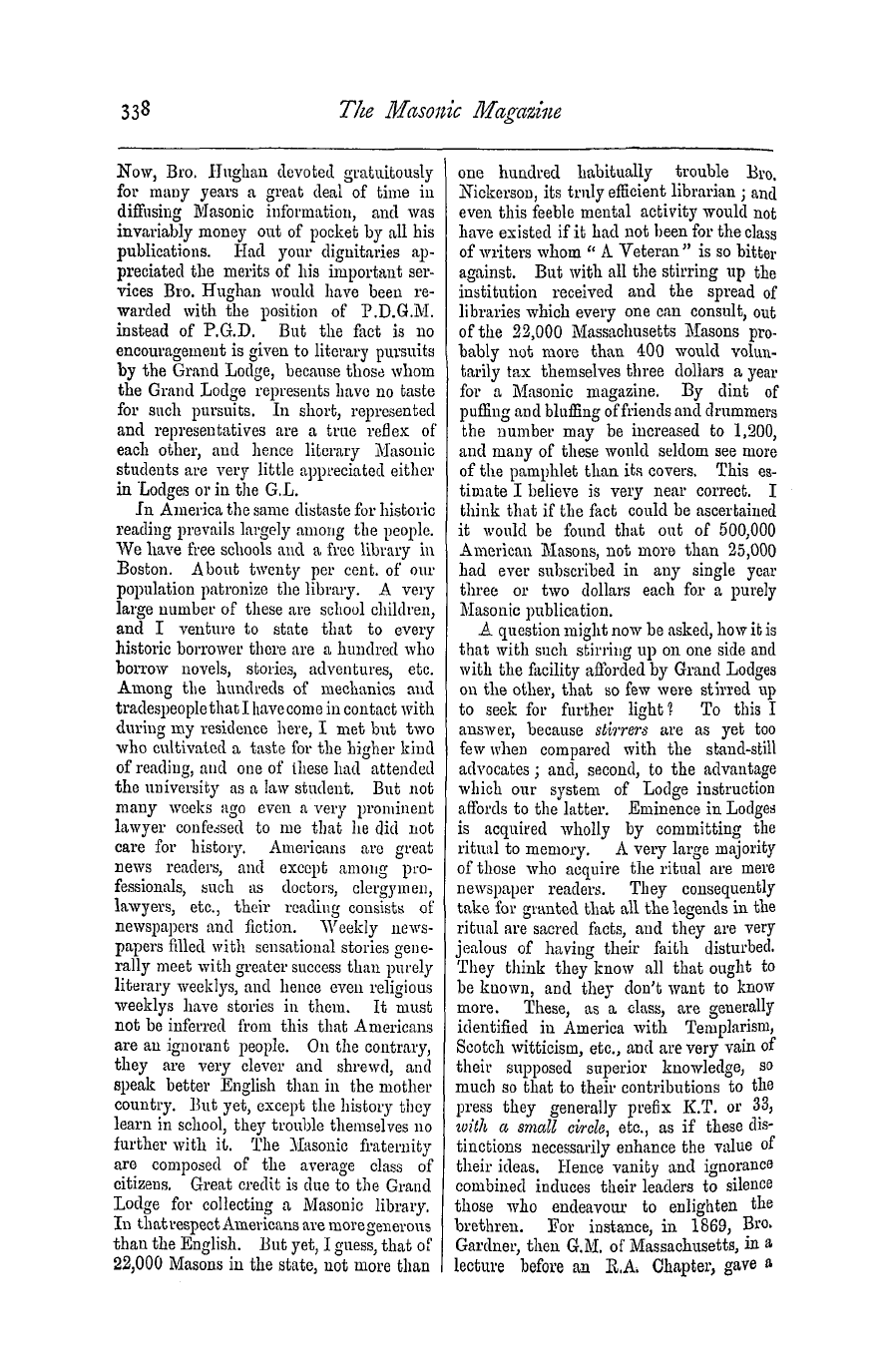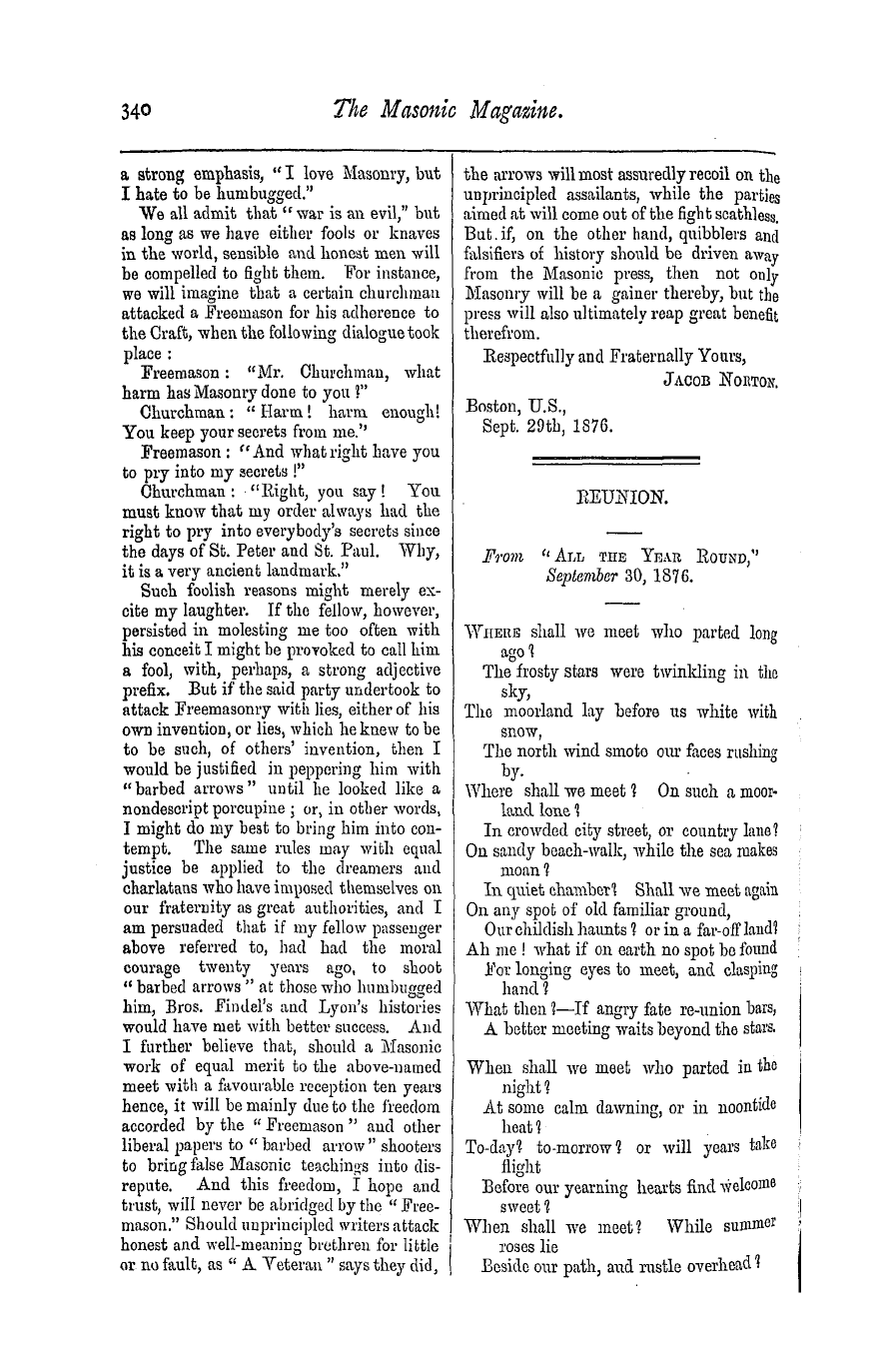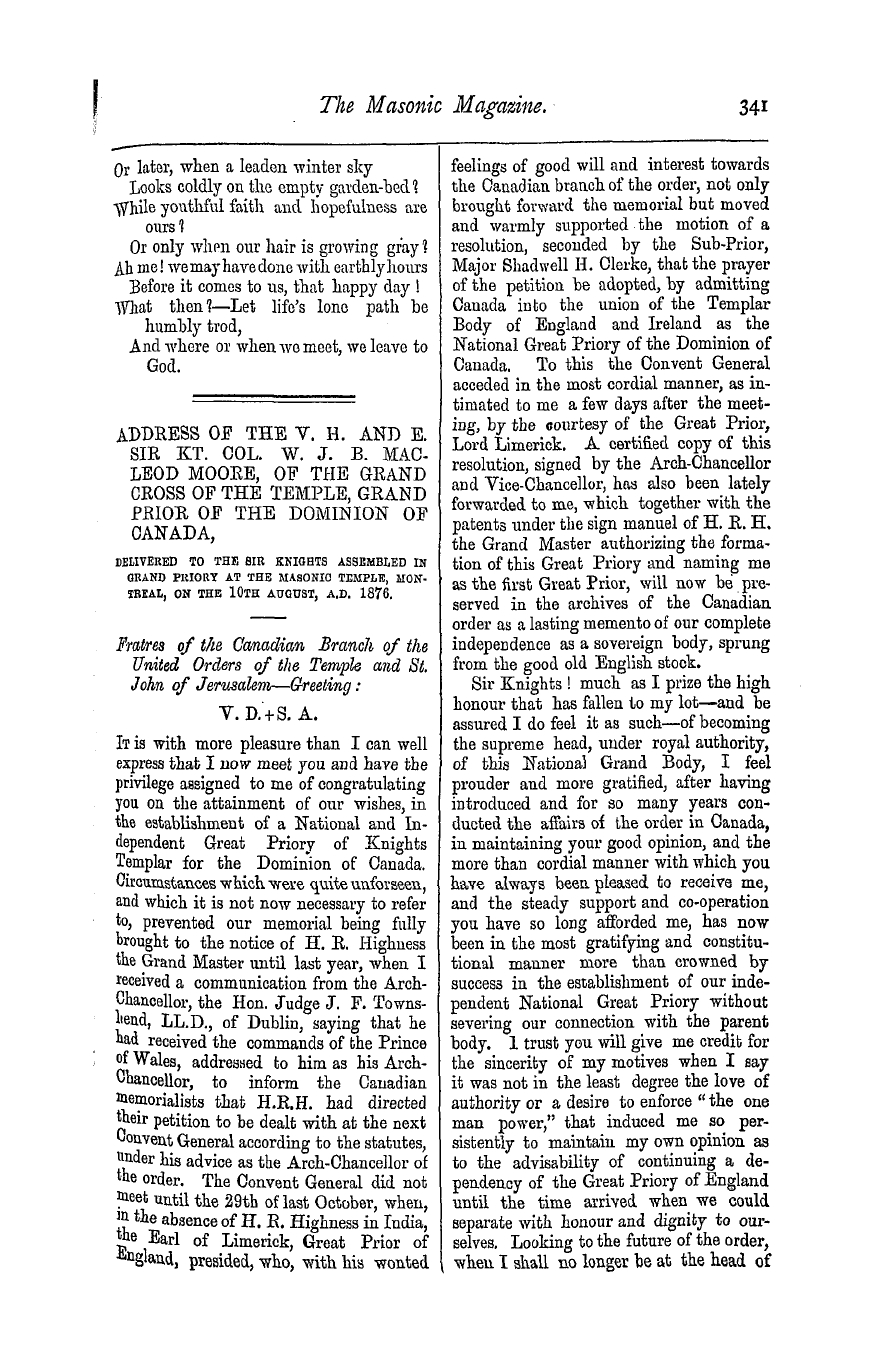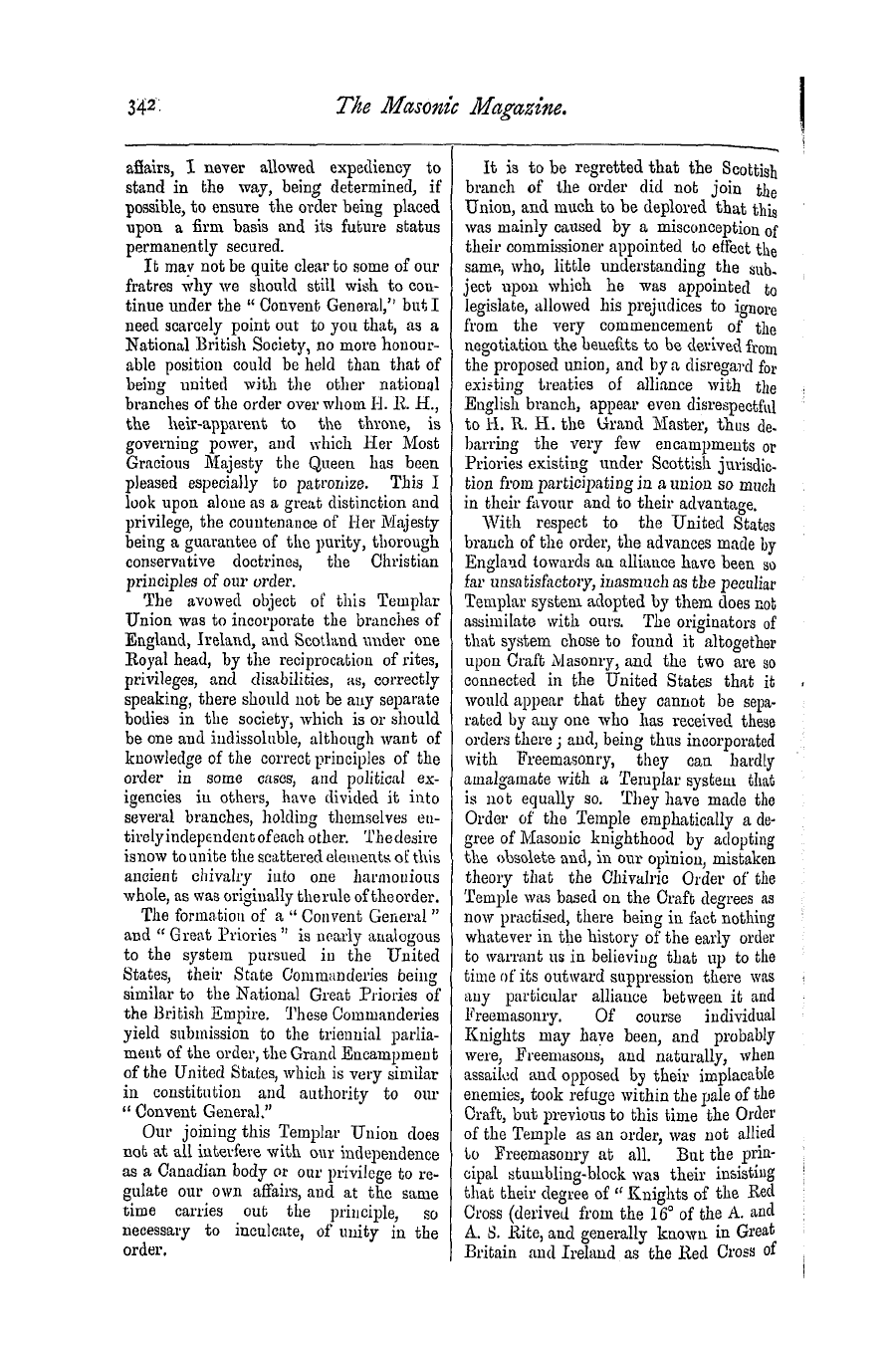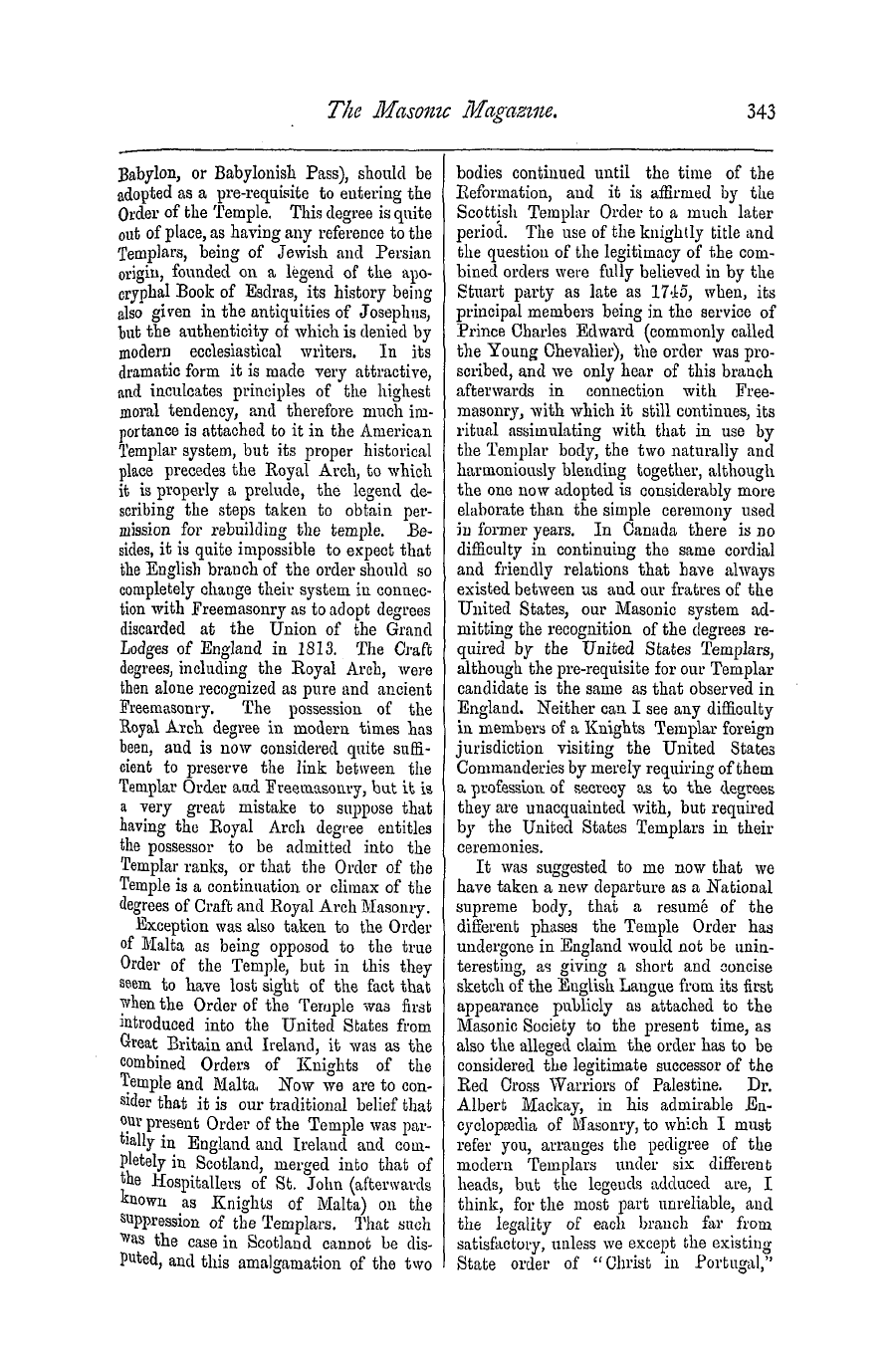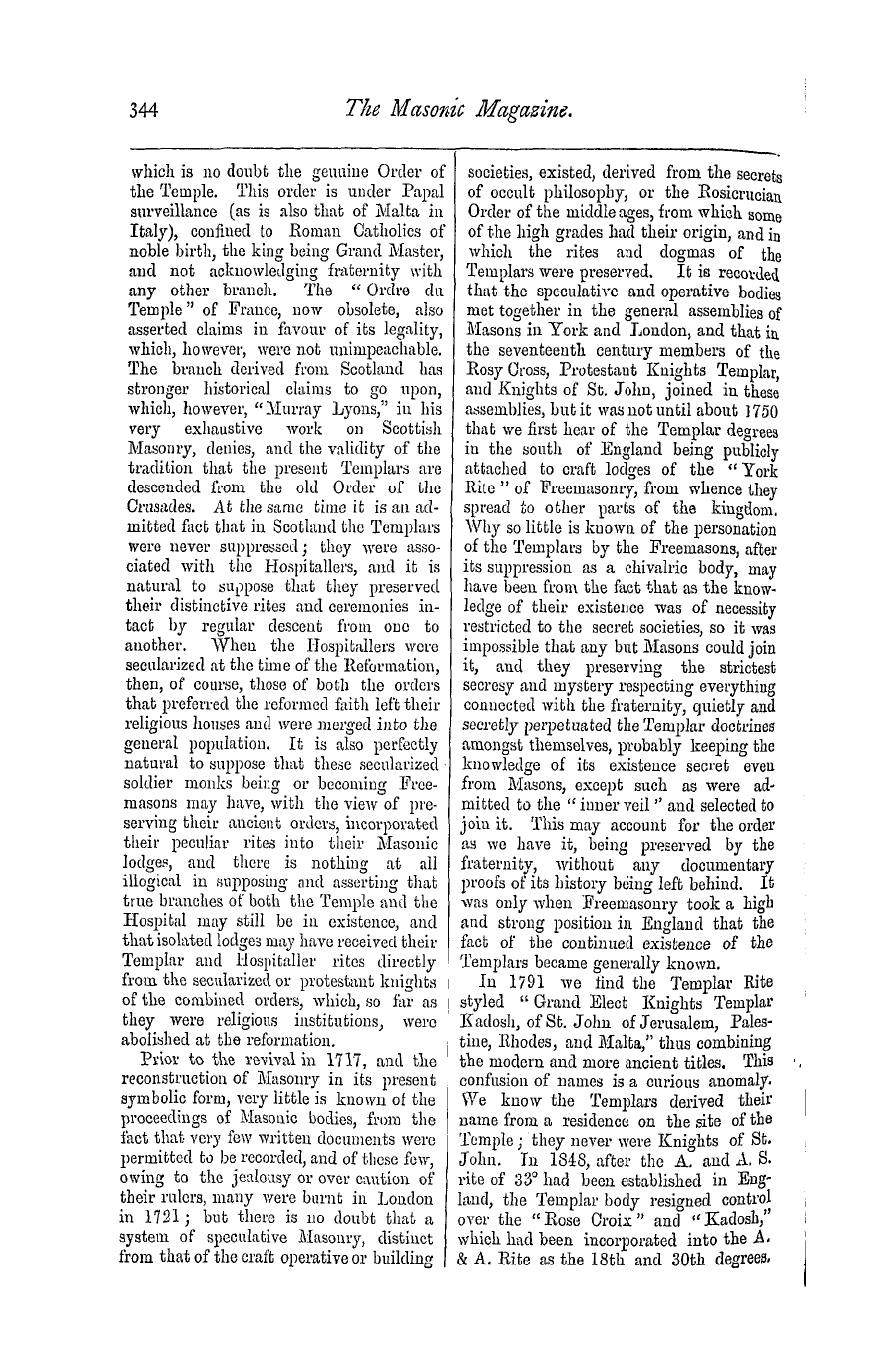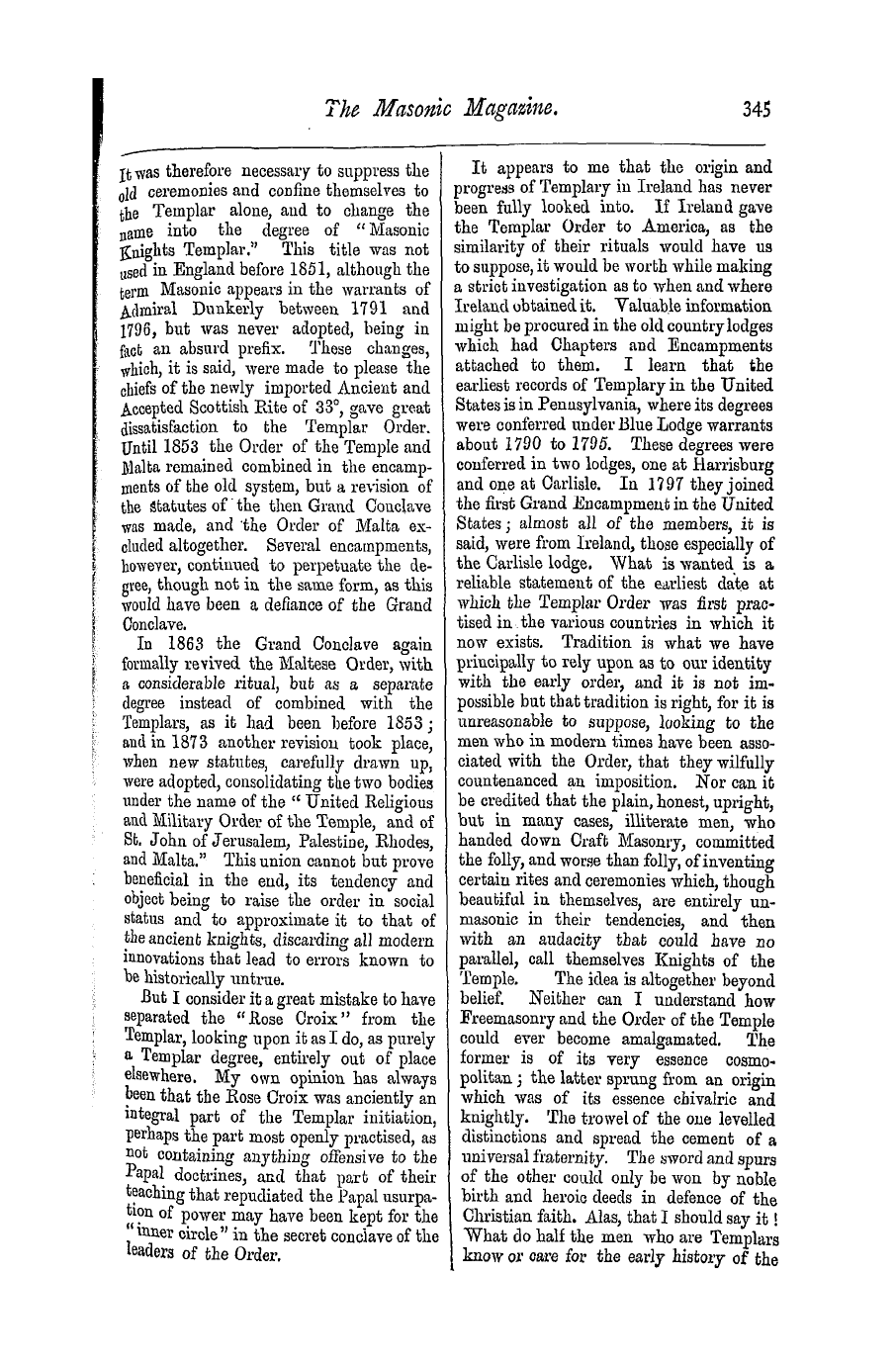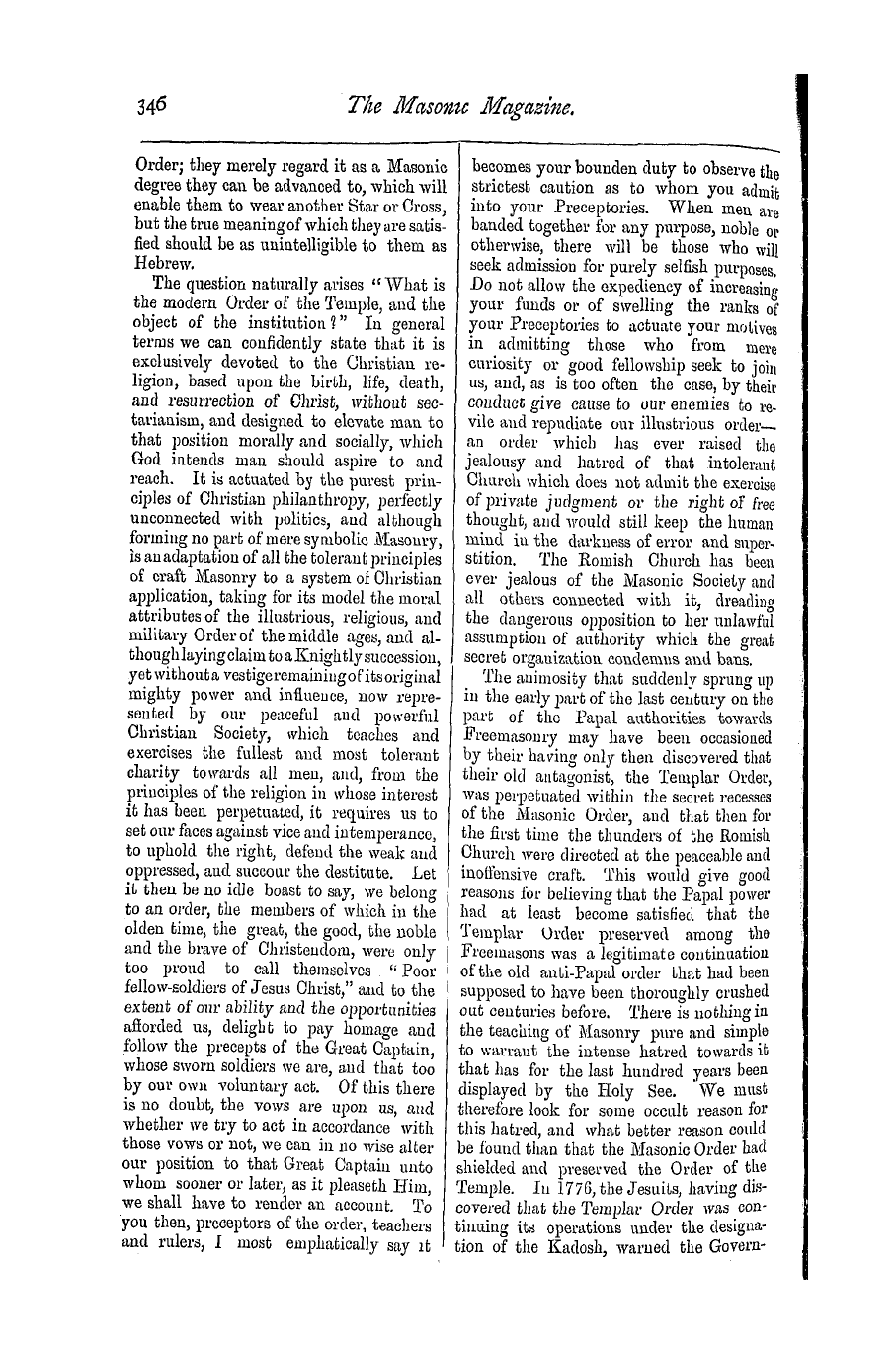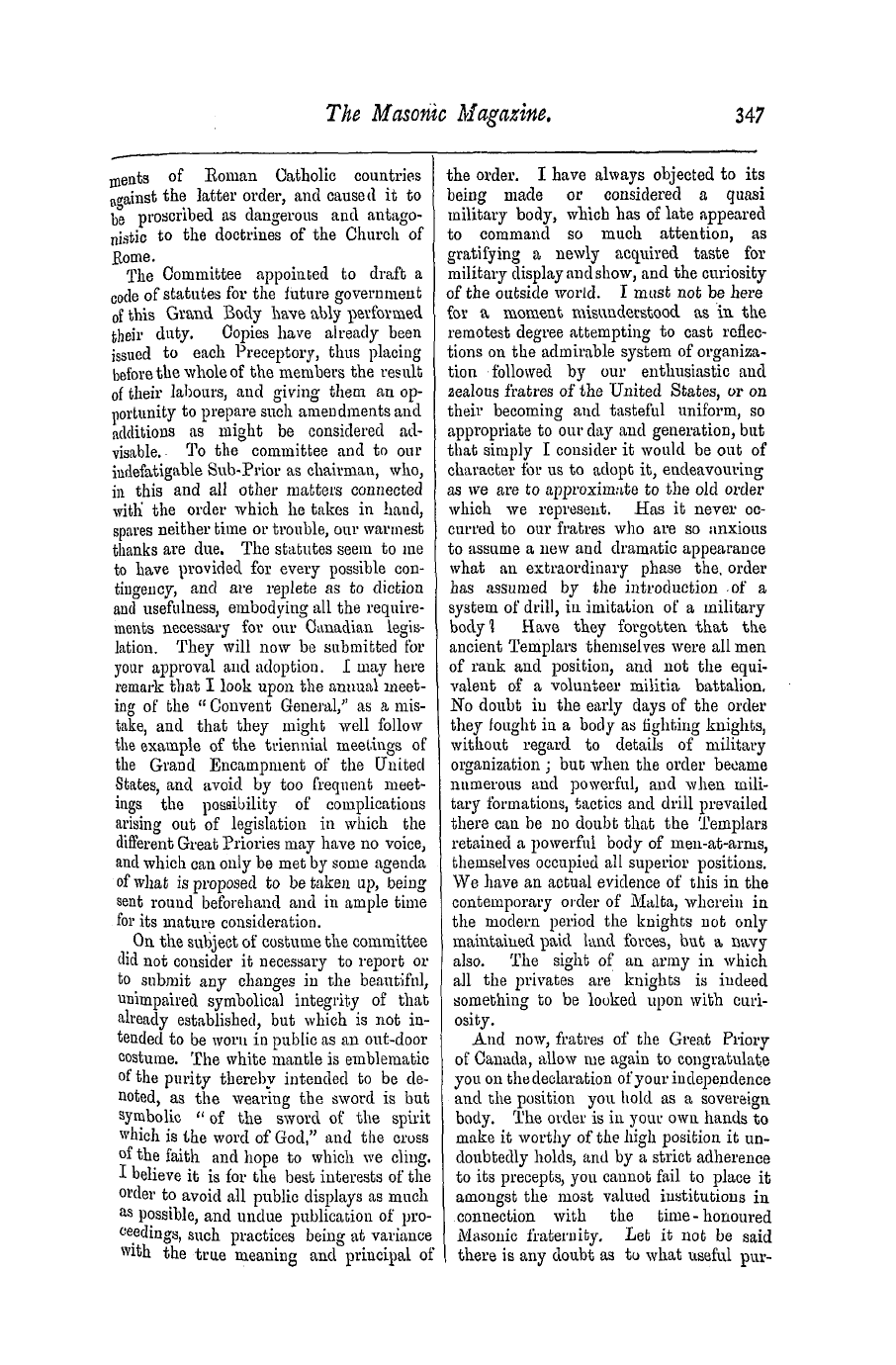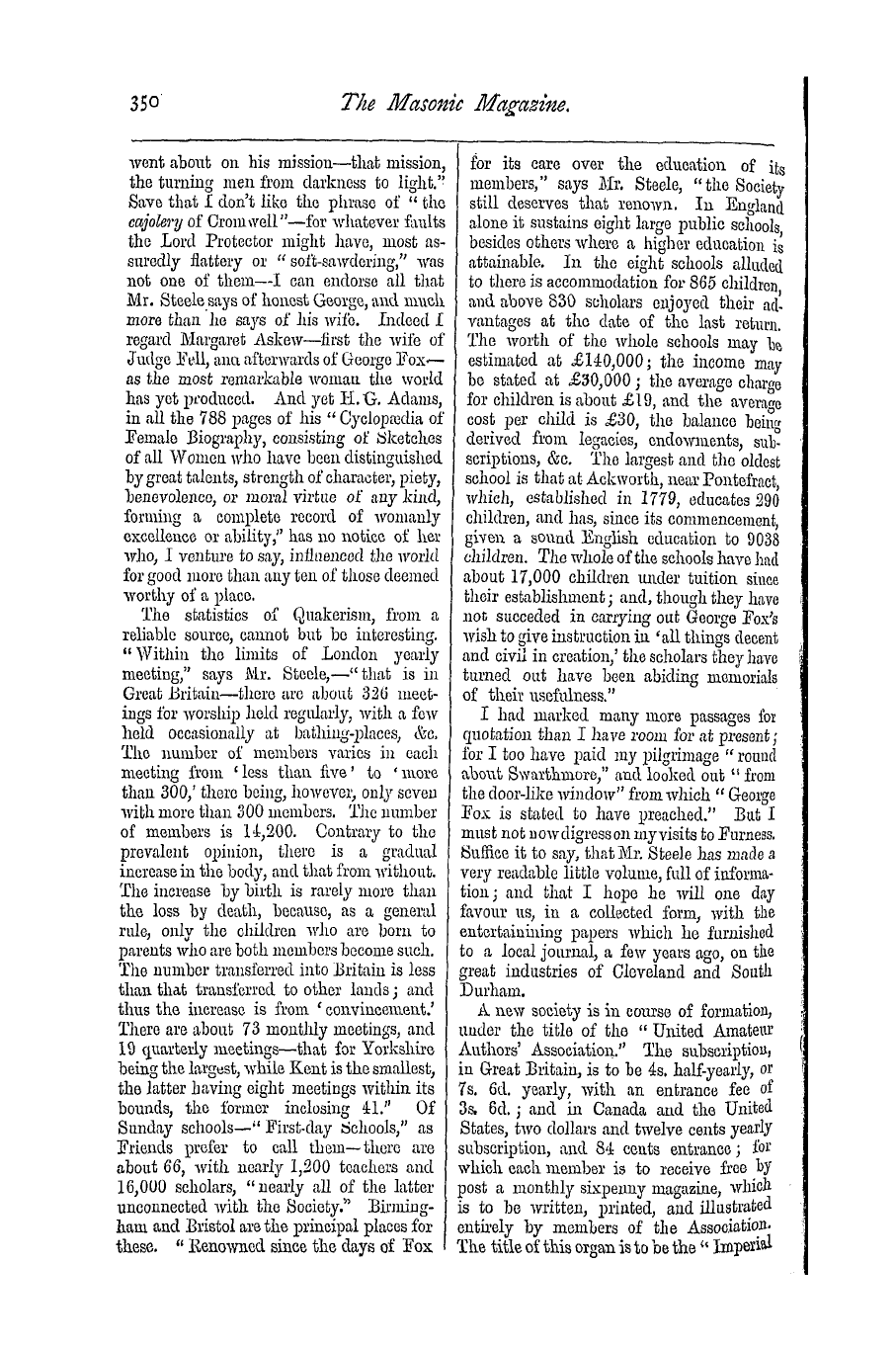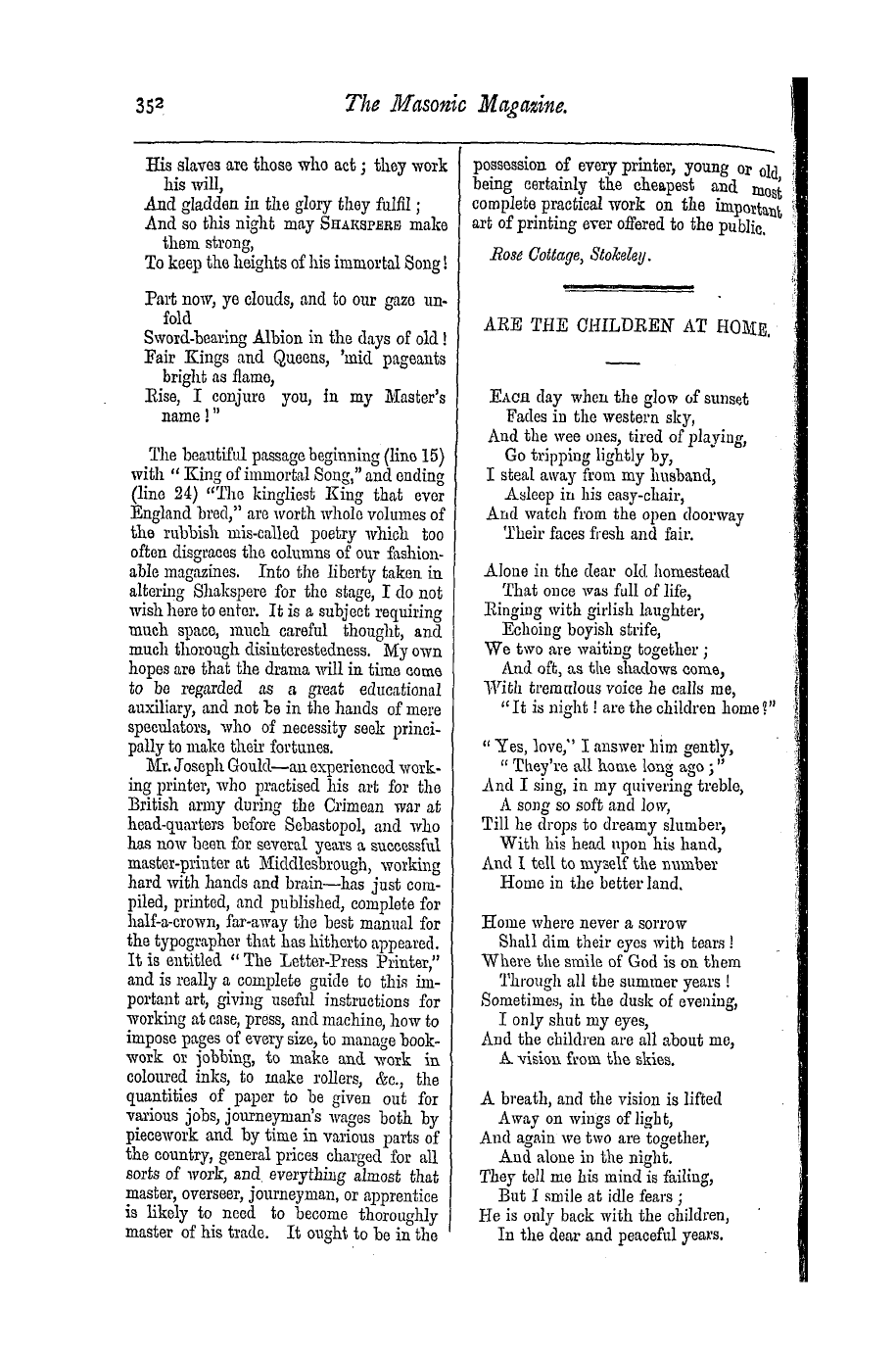Note: This text has been automatically extracted via Optical Character Recognition (OCR) software.
The Origin And References Of The Hermesian Spurious Freemasonry.
being different names and forms for one personification ; Juno , Ceres , and Rhea , for another ; and Proserpine and Isis for the third . Each of these general personifications , whether male or female , was endowed with three great attributes , the
powers of generation , preservation , and distinction , which , being separately personified in all their different modes of acting and existing , became distinct and subordinate deities . " * In consequence of the above theory , all
the Egyptian Kings , from the earliest Pharaoh to the last of the Roman Emperors , adopted , in the legends consecrated to their honour , the pompous titles of " Offspring of the Sun , son of the Sun , king , like the Sun , of all inferior and superior
regions ; " and the like . They had , besides , consecrated to the Sun , the city of Heliopolis , and thus each of the four principal cities of the empire , Thebes , Memphis , Sais , and Heliopolis was under the especial protection of one of these great deities . + It may , however , be conceived that these
deities were in reality the taunc emblem of the Sun under different appellations . Thus " Muevis , the bull of Heliopolis , was said to be sacred to the Sun , and Apis , the bull of Memphis , to the moon . But Macrobius has more accurately referred all the sacred bulls of Egypt to the Sun , in
the sign of Taurus . Strabo says that Apis was the same with Osiris ; and , according to Plutarch , the priests of Egypt considered this bull as a fair image of the soul of Osiris . Hence , no doubt , Lucian has called Apis the greatest god of the
E gyptians . " ! For these reasons , and others , which might be adduced , the hieroglyphic of the princi pal deity in the triad , viz ., the point within a circle , is inserted in the Tracing Board which the crowned or winged beetle ,
or Hermes , as the above mentioned Re , holds between its two fore legs , in conformit y with that sublime description of « ie deity which was contained in the Hermetic writings ; Deus cheilitis est , Clljus centrum ubique , circumferentia nus-Puam .
A Review.
A Review .
Life of the Prince Consort . By Theodore Martin , C . B . ( Vol . II . ) AFTER a lapse of two years , the second volume of this most interesting life appearsand Mr . Martin seems to be able to
, finish it in one more . Mr . Martin has had the most abundant stores of public papers and private memoranda submitted to his notice for his important task , and thus alludes to his most valuable sources of information : —
" In going through the volumes of State and other papers compiled by the Prince for the use of your Majesty and himself , nothing has impressed or touched me more than the indications on which I everywhere came of how the minds and hands
of your Majesty and the Prince had worked together upon the multiform and difficult questions which were constantly presenting themselves for consideration . It cannot but be well that your Majesty ' s subjects should learn something of the
noble activity which reigned within the Palace—how not a day , scarcely an hour , passed which did not leave its record of some good work done , some sagacious counsel tendered , some worthy enterprise encouragedsome measure to make men
, wiser or better devised or helped forward , some problem of grave , social , or political moment meditated to its depth and advanced towards a solution . "
The period over which this volume extends is from 1848 to 1854 , a very important epoch in the history of Europe , and which many of us remember with vivid emotions . It is thus that , writing to the Dowager
Duchess of Saxe-Cobourg , Prince Albert takes leave of 1848 : — " One is heartily glad to say goodbye to it ( the old year ) , and deeply grateful ought we to be that we have managed to come out of it with a whole skin . Still I fear
that mankind has not grown much wiser or better , and I see symptoms in the German sovereigns of an inclination to to repeat all the old faults , which have been within an ace of losing them their heads . "
Note: This text has been automatically extracted via Optical Character Recognition (OCR) software.
The Origin And References Of The Hermesian Spurious Freemasonry.
being different names and forms for one personification ; Juno , Ceres , and Rhea , for another ; and Proserpine and Isis for the third . Each of these general personifications , whether male or female , was endowed with three great attributes , the
powers of generation , preservation , and distinction , which , being separately personified in all their different modes of acting and existing , became distinct and subordinate deities . " * In consequence of the above theory , all
the Egyptian Kings , from the earliest Pharaoh to the last of the Roman Emperors , adopted , in the legends consecrated to their honour , the pompous titles of " Offspring of the Sun , son of the Sun , king , like the Sun , of all inferior and superior
regions ; " and the like . They had , besides , consecrated to the Sun , the city of Heliopolis , and thus each of the four principal cities of the empire , Thebes , Memphis , Sais , and Heliopolis was under the especial protection of one of these great deities . + It may , however , be conceived that these
deities were in reality the taunc emblem of the Sun under different appellations . Thus " Muevis , the bull of Heliopolis , was said to be sacred to the Sun , and Apis , the bull of Memphis , to the moon . But Macrobius has more accurately referred all the sacred bulls of Egypt to the Sun , in
the sign of Taurus . Strabo says that Apis was the same with Osiris ; and , according to Plutarch , the priests of Egypt considered this bull as a fair image of the soul of Osiris . Hence , no doubt , Lucian has called Apis the greatest god of the
E gyptians . " ! For these reasons , and others , which might be adduced , the hieroglyphic of the princi pal deity in the triad , viz ., the point within a circle , is inserted in the Tracing Board which the crowned or winged beetle ,
or Hermes , as the above mentioned Re , holds between its two fore legs , in conformit y with that sublime description of « ie deity which was contained in the Hermetic writings ; Deus cheilitis est , Clljus centrum ubique , circumferentia nus-Puam .
A Review.
A Review .
Life of the Prince Consort . By Theodore Martin , C . B . ( Vol . II . ) AFTER a lapse of two years , the second volume of this most interesting life appearsand Mr . Martin seems to be able to
, finish it in one more . Mr . Martin has had the most abundant stores of public papers and private memoranda submitted to his notice for his important task , and thus alludes to his most valuable sources of information : —
" In going through the volumes of State and other papers compiled by the Prince for the use of your Majesty and himself , nothing has impressed or touched me more than the indications on which I everywhere came of how the minds and hands
of your Majesty and the Prince had worked together upon the multiform and difficult questions which were constantly presenting themselves for consideration . It cannot but be well that your Majesty ' s subjects should learn something of the
noble activity which reigned within the Palace—how not a day , scarcely an hour , passed which did not leave its record of some good work done , some sagacious counsel tendered , some worthy enterprise encouragedsome measure to make men
, wiser or better devised or helped forward , some problem of grave , social , or political moment meditated to its depth and advanced towards a solution . "
The period over which this volume extends is from 1848 to 1854 , a very important epoch in the history of Europe , and which many of us remember with vivid emotions . It is thus that , writing to the Dowager
Duchess of Saxe-Cobourg , Prince Albert takes leave of 1848 : — " One is heartily glad to say goodbye to it ( the old year ) , and deeply grateful ought we to be that we have managed to come out of it with a whole skin . Still I fear
that mankind has not grown much wiser or better , and I see symptoms in the German sovereigns of an inclination to to repeat all the old faults , which have been within an ace of losing them their heads . "



































































